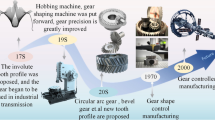Abstract
Hypoid gears are widely used in automobile differentials. Furthermore, it is well known that the efficiency of hypoid gears is lower than that of other gears due to offsets. However, only a few studies have focused on offsets. Thus, it is important to understand the meshing phenomenon of hypoid gears with different offsets. In a previous study, we attempted to develop a novel method to analyze tooth contact conditions as a non-contact analysis method based on monitoring the temperature distribution during meshing between the pinion and gear surface. We also developed a novel method to predict the tooth surface temperature in tooth meshing based on a thermal network model that represents the thermal conductivity of the object by a simple RC circuit. In this study, thermal images were taken by thermography, and the tooth root stress was measured for gear pairs with different offsets. The temperature increase under each offset condition was simulated using a thermal network model. The results demonstrated the versatility of the thermal network model. Monitoring the tooth surface temperature by thermography was useful for understanding phenomenon of gears with different offsets.
Zusammenfassung
Die Nutzung von Hypoidgetrieben ist in Differentialgetrieben von Automobilen weit verbreitet. Darüber hinaus ist es wohlbekannt, dass die Effizienz von Hypoidgetrieben wegen der Versetzung im Vergleich zu anderen Getrieben niedriger ist. Allerdings haben nur wenige Studien ihren Fokus auf die Versetzung gerichtet. Daher ist es wichtig, das Phänomen des Kämmens bei Hypoidgetrieben mit unterschiedlicher Versetzung zu verstehen. In einer vorherigen Studie haben wir versucht, eine neue Methode der Analyse von Zahn-Kontakt-Bedingungen als eine auf die Beobachtung der Temperaturverteilung während des Kämmens zwischen dem Ritzel und der Zahnradfläche basierende Analysemethode zu entwickeln. Ebenfalls haben wir eine neue Methode entwickelt, um die Temperatur auf der Zahnfläche beim Kämmen der Zähne – basierend auf einem Wärmenetz-Modell, welches die Wärmeleitfähigkeit des Objekts mit einem einfachen RC-Stromkreis darstellt – vorherzusagen. Im Rahmen dieser Studie wurden Wärmebilder durch Thermographie erstellt und die Zahnfußspannung an Zahnradpaaren mit unterschiedlicher Versetzung gemessen. Die Temperaturzunahme unter jeder Versetzungsbedingung wurde mittels eines Wärmenetz-Modells simuliert. Die Ergebnisse demonstrieren die Vielseitigkeit des Wärmenetz-Modells. Die Beobachtung der Zahnflächentemperatur mittels Tomographie erwies sich als nützlich, um das Phänomen bei Getrieben mit unterschiedlicher Versetzung zu verstehen.

























Similar content being viewed by others
References
Kakavas I, Olver AV, Dini D (2016) Hypoid gear vehicle axle efficiency. Tribol Int 101:314–323
Paouris L, Rahmani R, Theodossiades S, Rahnejat H, Hunt G, Barton W (2018) Inefficiency predictions in a hypoid gear pair through tribodynamics analysis. Tribol Int 119:631–644
Kolivand M, Li S, Kahraman A (2010) Prediction of mechanical gear mesh efficiency of hypoid gear pairs. Mech Mach Theory 45:1568–1582
Sakagami T, Nishimura T, Yamaguchi N, Kubo S (2006) Development of a new motion compensation technique in infrared stress measurement based on digital image correlation method. J JSME 72(724):1853–1859 (in Japanese)
Uenishi Y, Hirogaki T, Aoyama E, Nakano Y, Tange H, Katayama Y (2005) Construction of an estimating system of gear noise using thermography. J Japan Soc Mech Eng Ser C 71(703):1085–1090 (in Japanese)
Hirogaki T, Aoyama E, Pihet R, Niwa K (2014) Investigation of temperature hysteresis on tooth contact surface of hypoid gears using middle-infrared ray imagery based on thermal network model. J Adv Mech Des Syst 8(3):1–15
Hirogaki T, Aoyama E, Niwa K, Suzuki M (2016) Novel monitoring method of gear meshing based on combination of continuous shots with a thermography and prediction of tooth surface temperature by heat circuit network model. J Japan Soc Mech Eng Ser C 82(844):1–14 (in Japanese)
Okuyama H (1983) The theory and application of the simulation by the heat circuit. J Soc Heat Air-Conditioning Sanit Eng Jpn 541–544 (in Japanese)
Olver AV, Spikes HA (1998) Prediction of traction in elastohydrodynamic lubrication. Proc Inst Mech Eng J J Eng Tribol 212:321–332
Xu H, Kahraman A (2007) Prediction of friction-related power losses of hypoid gear pairs. P I Mech Eng K‑J Mul 221:387–400
Coleman W (1975) Computing efficiency for bevel and hypoid gears. Mach Des 64–65
Saiki K, Watanabe T, Shiraki K, Fukamachi S, Tobisawa K (2013) Development of high efficiency hypoid gear for automotive application. J Soc Automot Eng Jpn 44(1):63–68 (in Japanese)
Hirogaki T, Aoyama E, Nagata M, Iida T, Usui Y (2011) Tooth contact evaluation of hypoid gears using middle-infrared ray imagery. J Japan Soc Mech Eng Ser C 77(776):1574–1584
Tsukamoto N (1985) Investigation about the strength of plastic gears: 6th report, endurance limit and damage state of nylon gear for power transmission. B JSME 28(241):1528–1534
Deng G, Nakanishi T (1999) Evaluation of surface fatigue strength based on surface temperature (Surface temperature calculation for rolling-sliding contact). J Japan Soc Mech Eng Ser C 65(630):732–737 (in Japanese)
Coleman W (1967) A scoring formula for bevel and Hypoid gear teeth. T ASME Ser F 89(2):114–126
Ito N, Takahashi K, Nishino J (1996) Toe and heel tooth contact analysis of hypoid gear (1st report, theory). J Japan Soc Mech Eng Ser C 62(595):1120–1126 (in Japanese)
Author information
Authors and Affiliations
Corresponding author
Rights and permissions
About this article
Cite this article
Mukaiyama, K., Arao, S., Matsui, S. et al. Investigation of meshing phenomenon of hypoid gears with different offsets via high response infrared video thermography. Forsch Ingenieurwes 83, 445–459 (2019). https://doi.org/10.1007/s10010-019-00367-0
Received:
Accepted:
Published:
Issue Date:
DOI: https://doi.org/10.1007/s10010-019-00367-0




